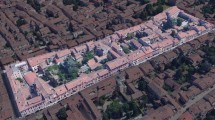Abstract
Collapse of masonry structures during an earthquake is analyzed using the three-dimensional distinct element method (3D-DEM) code developed by the first author. The DEM is a numerical analysis technique, in which positions of elements are calculated by solving equations of motion step by step. Both individual and group behavior can be simulated. The structure is modeled as an assembly of distinct elements connected by virtual springs and dashpots, where elements come into contact. First, the validity of the developed 3D-DEM code is confirmed by comparing analytical results with static experimental results of masonry walls. Second, failure process of masonry buildings due to earthquake is investigated using DEM. Effects of reinforcing methods are also examined. Finally, injury to human bodies in the collapsing masonry buildings is also calculated. Assuming that occupants lie down on the floor, two types of casualty criteria are introduced and assessed.





























Similar content being viewed by others
References
Bierawski LG, Maeno S (2006) DEM-FEM model of highly saturated soil motion due to seepage force. J Waterw Port Coast Ocean Eng 132(5):401–409. doi:10.1061/(ASCE)0733-950X(2006)132:5(401)
Coburn AW (1987) Seismic vulnerability and risk reduction strategies for housing in eastern Turkey. PhD Thesis, The Martin Centre for Architectural and Urban Studies, University of Cambridge, UK
Cundall PA (1974) Rational design of tunnel supports: a computer model for rock mass behavior using interactive graphics for the input and output of geometrical data. Technical Report MRD-2-74, Missouri River Division, US Army Corps of Engineers
Glass RI, Urrutia JJ, Sibony S, Smith H, Garcia B, Rizzo L (1977) Earthquake injuries related to housing in a Guatemalan village. Science 197:638–643. doi:10.1126/science.197.4304.638
Ikuta E, Miyano M, Nagashima F, Tanaka H, Nakamori Y (2004) Study on casualty due to earthquake by thoracic compression simulation. Jpn J Physiol Anthropol 24(2):92–93 (in Japanese)
Kawasumi H (1954) Intensity and magnitude of shallow earthquakes. Bur Cent Seism Intern 19:99–114
Kiyono J, Kalantari A (2004) Collapse mechanism of adobe and masonry structures during the 2003 Iran Bam earthquake. Bull Earthq Res Inst Univ Tokyo 79:157–161
Kume M (1961) Study on chest compression based on pathological physiology. J Jpn Assoc Thorac Surg 9(10):811–827 (in Japanese)
Lourenco PB (1994) Analysis of masonry structures with interface elements, theory and applications. Delft University of Technology, Faculty of Civil Engineering, TU-DELFT Report No. 03-21-22-0-01, TNO-BOUW Report No. 94-NW-R0762
Meguro K, Yoshimura M, Mayorca P, Takashima M (2004) Characteristics of adobe structure damage observed in Iran/Bam earthquake (Dec. 26, 2003). Mon J Ins Indus Sci Univ Tokyo 56(6):496–499
Ministry of Land Infrastructure and Transport (2001) National organization for automotive Safety & victims’ aid new car assessment Japan. Ministry of Land Infrastructure and Transport, Tokyo (in Japanese)
Miyakoshi J, Hayashi Y, Tamura K, Fukuwa N (1998) Damage ratio of buildings using damage data of the 1995 Hyogo-ken Nanbu earthquake. In: Proceedings of 7th international conference on structural safety and reliability, vol 1, pp 349–354
Molas GL, Yamazaki F (1995) Neural networks for quick earthquake damage estimation. Earthq Eng Struct Dyn 24:505–516. doi:10.1002/eqe.4290240404
Ohta Y, Goto N, Ohashi H (1983) An empirical construction of equations for estimating the number of victims in an earthquake. Jishin II 36:463–464 (in Japanese with English title)
Ohta Y, Murakami H, Watoh Y, Koyama M (2004) A model for evaluating life span characteristics of entrapped occupants by an earthquake. In: Proceedings of the 13th world conference on earthquake engineering, vol 1–9, Paper No. 232
Okada S, Kagami H (1991) Inventory vulnerability functions for earthquake damage evaluation in terms of the intensity scale of the Japan Meteorological Agency. Jishin II 44:93–108 (in Japanese with English abstract)
Okada S, Takai N (1999) The basic framework for casualty modeling of victims of earthquake. (1) Classification of structural types and damage patterns of buildings, and damage index function. Rep Tono Res Inst Earthq Sci 2:12–23 (in Japanese with English abstract)
Sakai S (1991) Survival modelling of victims trapped in collapsed buildings in an earthquake. J Nat Disaster Sci 13:69–95
Sathiparan N, Mayorca P, Nesheli KN, Guragain R, Meguro K (2005) Experimental study on in-plane and out-of-plane behavior of masonry wallettes retrofitted by PP-band meshes. Mon J Ins Indus Sci Univ Tokyo 57(6):26–29
Seligan HA, Shoaf KI (2002) Human impacts of earthquakes. In: Chen WF, Scawthorn C (eds) Earthquake engineering handbook. CRC Press, Boca Raton
Spence R, Bayulke N, Coburn A, Hibbs A (1987) Impulse table tests on stone masonry houses. The Martin Center for Architectural and Urban Studies Department of Architecture, Cambridge University, Cambridge
Von Glerke HE, Brammer AJ (2002) Effects of shock and vibration on humans. In: Harris CM, Piersol AG (eds) Shock and vibration handbook, 5th edn. McGraw Hill, New York
Author information
Authors and Affiliations
Corresponding author
Rights and permissions
About this article
Cite this article
Furukawa, A., Ohta, Y. Failure process of masonry buildings during earthquake and associated casualty risk evaluation. Nat Hazards 49, 25–51 (2009). https://doi.org/10.1007/s11069-008-9275-x
Received:
Accepted:
Published:
Issue Date:
DOI: https://doi.org/10.1007/s11069-008-9275-x




